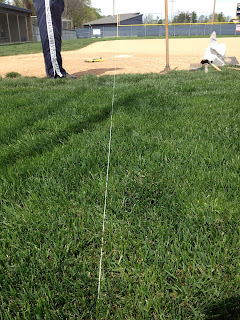Before we get to the photos, lets lay out a couple of items in regards to infield drainage:
- Do NOT install drain tiles under the infield mix. The infield mix should be engineered and maintained to eliminate downward movement (percolation) of water. All water during rain events should run off the infield.
- Due to item #1, positive surface drainage must be achieved on ALL infields. For baseball and softball, surface drainage should be between .5% and 1%. Keep in mind, if a softball field does not have sod in front of dugouts, surface drainage should be NO MORE than .5%. Does your infield conditioner run off your infield? Chances are, the infield has surface drainage exceeding the limits listed above.
- Purchase and manage a good infield mix. Be careful when purchasing infield mix! To learn more about infield mixes, click HERE and HERE.
So, lets explain what the existing conditioners were at Baumgartner Field at University of Indianapolis:
- Native soil.
- Due to existing topography, the grade falls from the RF foul pole to the 3rd base dugout.
- Bluegrass/Ryegrass surface
- Infield Mix - Dura Edge Classic
- Conditioner - Diamond Pro Professional Calcined Clay
- Mound Clay - Dura Pitch Mound Clay
- During rain events, water would run from RF under the tarp and become trapped.
The solution:
Install a six inch wide trench:
Next, installation of a 4 inch perforated drain tile and 6 inches of USGA drainage gravel.
Then, installation of 6 inches of USGA rootzone sand all the way to the surface. Then the existing sod was re-installed. DO NOT seal off drain tiles by placing native soil over drainage gravel.
Finally, an edger was used to run across the trench/slit and expose 3 inches of the sand. The bluegrass will grow into the sand.
The location of the drain tile while the tarp is on the field.
Lastly, the field ready for play the day after installation.
Mission accomplished!
Best of luck to the Lady Greyhounds as they begin the road to the D-II College World Series.
Click HERE to learn more about Dura Edge Classic and Dura Pitch Mound Clay.
Click HERE to learn more about Diamond Pro Professional Calcined Clay.
Click HERE to learn more about UIndy softball
Go to j-dturf.com to learn more about J&D Turf.
Play on!
--Jamie
@JamieMehringer

















































